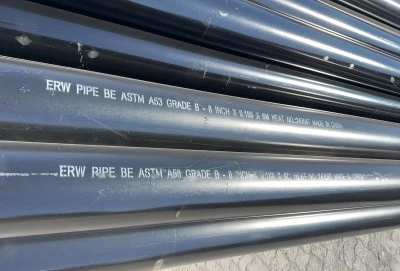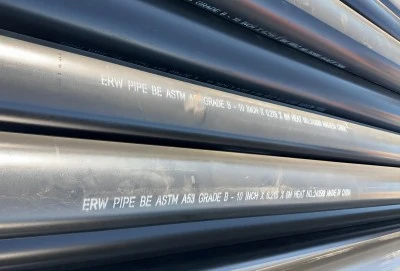In the world of steel pipe manufacturing, two common types often come up in discussions: ERW (Electric Resistance Welded) pipes and welded pipes. While both are essential in various industries, they have distinct characteristics that set them apart. This article will explore the differences between ERW and welded pipes, focusing on their concepts, manufacturing processes, material and performance differences, and application areas.
|
|
|
Concept and Manufacturing Process
ERW pipes, short for Electric Resistance Welded pipes, are a specific type of welded pipe. The manufacturing process of ERW pipes involves using electrical resistance to heat and join the edges of a steel strip or coil. This process creates a continuous weld seam along the length of the pipe.
The ERW pipe manufacturing process typically follows these steps:
- A steel strip is uncoiled and fed into the production line.
- The strip is gradually formed into a circular shape using rollers.
- The edges of the strip are brought together and heated using high-frequency electrical current.
- Pressure is applied to fuse the heated edges, creating a weld seam.
- The pipe is cooled and undergoes further processing, such as sizing and heat treatment.
On the other hand, the term "welded pipe" is a broader category that includes various welding methods. While ERW is one type of welded pipe, other welding techniques exist, such as:
- Submerged Arc Welding (SAW)
- Double Submerged Arc Welding (DSAW)
- Spiral Welding
- Laser Welding
These welding methods differ in their heat sources, welding processes, and the resulting pipe characteristics. For instance, SAW uses an arc between a continuously fed electrode and the workpiece, hidden beneath a blanket of granular flux. This method is often used for larger diameter pipes and can produce thicker wall pipes compared to ERW.
The choice between ERW and other welding methods depends on factors such as pipe diameter, wall thickness, material properties, and intended application.
Material and Performance Differences
ERW pipes and other welded pipes can be made from various steel grades, but there are some differences in their material properties and performance characteristics:
Material Selection: ERW pipes are typically made from hot-rolled or cold-rolled steel strips. The steel grades used for ERW pipes often include low-carbon steels and some low-alloy steels. Other welded pipes, particularly those made using SAW or DSAW methods, can be produced from a wider range of steel grades, including higher-strength and more alloyed steels.
Wall Thickness: ERW pipes generally have limitations on wall thickness, typically ranging from 2mm to 20mm. Other welding methods, such as SAW, can produce pipes with thicker walls, sometimes exceeding 50mm.
Diameter Range: Electric resistance welded steel pipes are commonly produced in diameters ranging from 1/2 inch to 24 inches (12.7mm to 610mm). Larger diameter pipes are usually manufactured using other welding methods like SAW or spiral welding.
Weld Seam Characteristics: ERW pipes have a narrow, consistent weld seam due to the electrical resistance welding process. This can result in a smoother internal surface compared to some other welding methods. However, other welding techniques may offer advantages in terms of weld strength and toughness, especially for thick-walled pipes.
Heat-Affected Zone (HAZ): The HAZ in ERW pipes is typically narrower compared to other welding methods. This can be advantageous in terms of maintaining consistent material properties across the pipe body and weld area.
Pressure Ratings: Due to their manufacturing process and typical wall thickness range, ERW pipes are often used for low to medium pressure applications. Other welded pipe types, particularly those with thicker walls, can be suitable for higher pressure applications.
Corrosion Resistance: The corrosion resistance of both ERW and other welded pipes depends primarily on the base material and any applied coatings. However, the narrower HAZ in ERW pipes may offer some advantages in corrosion resistance in certain environments.
Application Differences
The differences in manufacturing processes and material characteristics lead to varied applications for ERW pipes and other welded pipes:
ERW Pipe Applications:
- Water and sewage transportation
- Oil and gas distribution (low to medium pressure)
- Structural applications (e.g., scaffolding, fencing)
- Automotive industry (e.g., exhaust systems)
- HVAC systems
- Fire protection systems
- Furniture manufacturing
Other Welded Pipe Applications:
- High-pressure oil and gas transmission pipelines
- Offshore oil and gas platforms
- Large-diameter water mains
- Piling and foundation work
- Power plant construction
- Chemical and petrochemical industries
- Mining operations
The choice between ERW pipes and other welded pipes depends on various factors, including:
- Required pipe diameter and wall thickness
- Operating pressure and temperature
- Environmental conditions (e.g., corrosive environments)
- Mechanical property requirements
- Cost considerations
- Availability of manufacturing facilities
In many cases, ERW pipes offer a cost-effective solution for applications that fall within their diameter and wall thickness ranges. Their efficient manufacturing process and consistent quality make them a popular choice in various industries. However, for applications requiring larger diameters, thicker walls, or specific material properties, other welding methods may be more suitable.
Contact Longma Group
Understanding the differences between ERW pipes and other welded pipes is crucial for making informed decisions in pipe selection. While ERW pipes offer advantages in terms of cost-effectiveness, consistent quality, and suitability for many common applications, other welding methods provide solutions for more demanding or specialized requirements.
Are you in search of high-quality electric resistance welded steel pipes for your business? Longma Group is here to meet your needs. We specialize in producing pipes with a wide range of standards, including ASTM A53 Gr.B; API 5L: Gr.B,X42,X46, X52,X56,X60,X65,X70,X80 PSL1 and PSL2; ASTM A252, ASTM A500, AS/NZS 1163, AS/NZS1074, EN10219, EN10217 and more. Our products feature an outer diameter of 1/4"-20" (13.7mm--508mm), thickness of SCH10-SCH160 (6.35mm-59.54mm), and length from 6m to 18m, with options of BE (Beveled Ends) and PE (Plain Ends). Don't miss the opportunity to enhance your business with our excellent steel pipes. Contact us now at info@longma-group.com to explore how we can be your reliable partner in steel pipe solutions.














